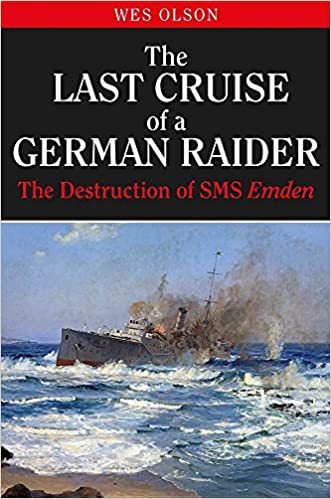Olson tells of the destruction of SMS Emden – not simply the tale of a naval battle. It is also a very good read!

Hardback 289pp RRP $45.75
Olson details the significance of SMS Emden’s raiding activities in the Indian Ocean and the corresponding importance of stopping them. He describes the fate of Emden’s crew members who were sent ashore prior to, and so missed, the battle and loss of their ship and finally, includes an account of the fate of Emden’s wreck at the hands of salvagers, looters and vandals.
On 31st July 1914, before the First World War combatants included Britain and Australia, Germany was at war with Russia and the SMS Emden, a light cruiser armed with 10 four-inch guns and torpedoes set sail for Tsingtao in search of the Russian Pacific Squadron. By August 5th the British Empire and Germany were at war and by the 11th August the British Imperial Fleet, including ships of the Australian squadron, were hunting all the ships of the substantial German Pacific Fleet. By this time SMS Emden had been detached and her captain, von Muller, had been simply ordered to “wage a vigorous campaign” in the Indian Ocean.
And that is exactly what SMS Emden accomplished. By the end of October Emden had intercepted thirty-one ships, seizing their cargoes and sinking seventeen, including two warships. SMS Emden had caused enormous disruption of trade, staggering monetary losses and huge logistical penalties to Allied fleets who were guarding ports and convoys and searching for her. The embarkation of the first ANZAC convoy to Egypt meant that Emden had to be neutralized before she found the convoy.
Emden attacked the Cocos Islands radio station with a landing party on 9th November. Before the raid the radio station reported a strange warship and HMAS Sydney was dispatched. Incorrectly identifying Sydney as HMS Newcastle, a cruiser of similar capabilities as his own ship, von Muller took the attack directly to Captain Glossop on the Sydney which was larger, faster, more heavily armoured and boasting superior armament of 8 six-inch guns firing 45kg projectiles two and a half times heavier than Emden from a range two miles further away.
The unequal contest is clearly described by Olson. He reveals, at length, the awesome and awful impact on the human body of high explosive naval gunfire. He also details the remarkable and interesting escape of the Cocos Island landing party, led by von Mucke, across the Indian Ocean in an old schooner and then overland to safety in Turkey. Finally, there is a whole chapter devoted to the wreck and the disposition, throughout the world, of the various components, relics and souvenirs retrieved from the SMS Emden.
A feature of this book is clear maps showing the relevant events and ship movements. There are also many interesting photographs with extensive notations. It is unfortunate that some of the photographs are presented in too small a format to easily make out some the more interesting points.
There are extensive notes on each chapter. Several useful appendices show both ships’ complements, including those detached for shore raids, honours and awards for both crews and the ships intercepted by Eden and their fate. Olson has also included a Glossary, List of Abbreviations used and tables of conversion for units of measure and, most interestingly, comparative ranks between the German and British Imperial naval ranks.
This book is clearly written making it an easy and informative read; Olson simply presents the facts ascertained from first-hand accounts. He mentions, but neither elaborates nor discusses, the controversy around Sydney’s continued shelling of Emden after it was beached. Similarly Olson reiterates the prevailing view, at the time, of von Muller’s chivalry, honour and bravery but ignores, as this reader wonders, whether, after realizing he was substantially outgunned, he should have surrendered his ship sooner, saving unnecessary loss of his crew, many of whom also died as a result of the Emden’s beaching.
Reviewed for RUSIV by Kevan Sanderson, November 2019
Contact Royal United Services Institute about this article.






